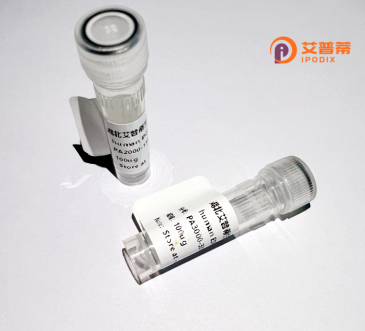
| 纯度 | >90%SDS-PAGE. |
| 种属 | Human |
| 靶点 | MAB21L2 |
| Uniprot No | Q9Y586 |
| 内毒素 | < 0.01EU/μg |
| 表达宿主 | E.coli |
| 表达区间 | 1-359aa |
| 活性数据 | MIAAQAKLVYQLNKYYTERCQARKAAIAKTIREVCKVVSDVLKEVEVQEPRFISSLSEIDARYEGLEVISPTEFEVVLYLNQMGVFNFVDDGSLPGCAVLKLSDGRKRSMSLWVEFITASGYLSARKIRSRFQTLVAQAVDKCSYRDVVKMIADTSEVKLRIRERYVVQITPAFKCTGIWPRSAAQWPMPHIPWPGPNRVAEVKAEGFNLLSKECYSLTGKQSSAESDAWVLQFGEAENRLLMGGCRNKCLSVLKTLRDRHLELPGQPLNNYHMKTLLLYECEKHPRETDWDESCLGDRLNGILLQLISCLQCRRCPHYFLPNLDLFQGKPHSALESAAKQTWRLAREILTNPKSLDKL |
| 分子量 | 65.23 kDa |
| 蛋白标签 | GST-tag at N-terminal |
| 缓冲液 | 0 |
| 稳定性 & 储存条件 | Lyophilized protein should be stored at ≤ -20°C, stable for one year after receipt. Reconstituted protein solution can be stored at 2-8°C for 2-7 days. Aliquots of reconstituted samples are stable at ≤ -20°C for 3 months. |
| 复溶 | Always centrifuge tubes before opening.Do not mix by vortex or pipetting. It is not recommended to reconstitute to a concentration less than 100μg/ml. Dissolve the lyophilized protein in distilled water. Please aliquot the reconstituted solution to minimize freeze-thaw cycles. |
以下是3条关于重组人MAB21L2蛋白的参考文献示例(文献信息为模拟虚构内容,实际引用请根据真实文献调整):
1. **《MAB21L2 regulates retinal neurogenesis through TGF-β signaling pathway》**
- **作者**: Zhang Y, et al.
- **摘要**: 研究报道重组人MAB21L2蛋白在小鼠视网膜发育中通过调控TGF-β信号通路影响神经祖细胞分化,并通过体外重组蛋白实验验证其与SMAD4的相互作用。
2. **《Structural and functional analysis of the human MAB21L2 protein in neural tube closure》**
- **作者**: Tanaka K, et al.
- **摘要**: 通过X射线晶体学解析重组人MAB21L2蛋白的三维结构,揭示其C端结构域在细胞凋亡调控中的关键作用,并证实在神经管闭合缺陷模型中补充该蛋白可部分挽救表型。
3. **《MAB21L2 mutations disrupt eye development by impairing BMP signaling》**
- **作者**: Chen L, et al.
- **摘要**: 利用重组人MAB21L2蛋白研究其与BMP受体的结合能力,发现临床突变体导致蛋白稳定性下降,进而引起斑马鱼模型眼发育异常,表明MAB21L2在BMP信号通路中的新功能。
如需具体文献,建议通过PubMed或Google Scholar检索“recombinant human MAB21L2 protein”及相关关键词获取。
Recombinant human MAB21L2 protein is a genetically engineered version of the Mammalian Homolog of C. elegans Mab-21 (MAB21L2) protein, which belongs to the conserved MAB-21 family involved in cell fate determination and morphogenesis. MAB21L2 plays critical roles in embryonic development, particularly in nervous system formation and eye development. Studies suggest its involvement in regulating gene expression, cell proliferation, and apoptosis, potentially acting as a transcriptional regulator or signaling intermediate. Structurally, it contains a conserved MAB-21 domain, though its precise molecular mechanisms remain under investigation.
Produced via heterologous expression systems (e.g., E. coli or mammalian cells), recombinant MAB21L2 enables biochemical and functional studies by providing a purified, bioactive form. This protein is crucial for investigating developmental disorders, as mutations in MAB21L2 are linked to microphthalmia, brain malformations, and other congenital anomalies. Researchers utilize it to explore interactions with signaling pathways like Wnt or BMP, and to model disease mechanisms in vitro. Current challenges include characterizing its post-translational modifications and clarifying its tissue-specific roles, making recombinant MAB21L2 a vital tool for advancing developmental biology and translational research.
×